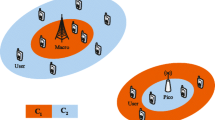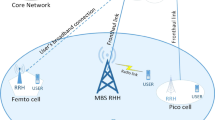Abstract
In the context of heterogeneous and small cell networks, users will have the possibility to connect to multiple radio access (RA) carriers that will be available by a dense deployment of RA infrastructure consisting of high-power and low-power access nodes. Determining which RAs a user should be associated with and select from, for its downlink transmissions, depends on the long-term and short-term data rates that these RAs may offer to the user. In this study the multi-RA association and utilisation is decomposed into a multi-RA to user association problem that assigns multiple RAs to users, and a multi-RA selection problem that determines which of the assigned RAs should be used at any time for the user transmissions. As a solution to the first problem, we propose a distributed dual-based spectrum access scheme (DSA) that considers multi-connectivity, whilst, the second problem is solved by means of a heuristic multi-RA selection scheme that utilise different multi-radio transmit diversity (MRTD) schemes while taking into account different inter-cell interference coordination (ICIC) schemes. Our two-step approach is evaluated by means of simulations which demonstrate cell-edge user throughput performance improvements that exceed 100 % when the multi-connectivity DSA is employed. Further significant user rate and energy efficiency improvements up to 69 and 38 % respectively can be achieved when MRTD is combined with ICIC.







Similar content being viewed by others
Notes
In 3GPP LTE-A [22], each aggregated carrier, which is referred to as a component carrier (CC), can have a bandwidth of 1.4, 3, 5, 10, 15 or 20 MHz and a maximum of five component carriers can be aggregated, hence the maximum aggregated bandwidth is 100 MHz.
The coefficient \(c_{i,j}^{(s)} =\log _2(1+\gamma _{i,j})\) is an estimate of the spectral efficiency offered by access node j determined by measuring the SINR \(\gamma _{i,j}\) of reference signals transmitted by access node j. The coefficients \(\lambda _j^{(s)}\), as we shall clarify later, are computed by the access nodes and broadcast to the mobile users.
This direct assumption will be revisited and reassessed later when we discuss how MRTD and ICIC schemes are combined.
A frequency reuse factor of one, also called 1-reuse, \(F=1\) implies a set of frequencies that is used by all access nodes in the same segment, \({\hat{W}}_j^{(s)}=W_j^{(s)}\); whilst in 3-reuse, \(F=3\), the bandwidth size of RA (j, s) is \(W_j^{(s)}/3\).
In the case the RAs also correspond to two different RATs, then this reflects the coexistence of two communication standards in the network operating in different frequency bands, e.g., WCDMA, HSPA, LTE, etc.
For the convenience of the reference the labels of the user distribution scenarios follows that of [3].
The average number of TTIs varies between 350 and 500 depending on the user distributions and the pico density of the simulated scenario.
It has to be noted here that in Configuration 4b the gains related to path loss are higher since users are clustered around pico nodes with higher probability, while the user rates of MRTD in Configuration 1 are lower.
Figure shows spectral efficiency in bps/Hz/RA. When PMRTD is used, users have access to 2 RAs, thus, the aggregate spectral efficiency of PMRTD is higher than SMRTD.
References
Cisco, “Cisco visual networking index: Global mobile data traffic forecast update 2014-2019,” 2015. [Online]. Available: http://www.cisco.com/c/en/us/solutions/collateral/service-provider/visual-networking-index-vni/white_paper_c11-520862.pdf.
3GPP, “TS 36.300 Evolved Universal Terrestrial Radio Access (E-UTRA)and Evolved Universal Terrestrial Radio Access Network (E-UTRAN); Overall description; Stage 2 (Release 12) (V12.5.0),” 3rd Generation Partnership Project (3GPP), Technical Specification Group Radio Access Network, Technical specification, March 2015.
3GPP, “TR 36.814, 3rd Generation Partnership Project; Technical Specification Group Radio Access Network; Evolved Universal Terrestrial Radio Access (E-UTRA): Further Advancements for E-UTRA Physical Layer Aspects (Release-9)(v9.0.0),” 3rd Generation Partnership Project (3GPP), Technical Specification Group Radio Access Network, Technical report 36.814, September 2013.
J. Zander and P. Mähönen, “Riding the data tsunami in the cloud: myths and challenges in future wireless access,” IEEE Communications Magazine, vol. 51, no. 3, pp. 146–151, March 2013.
J. Hoydis, M. Kobayashi, and M. Debbah, “Green small-cell networks - a cost- and energy-efficient way of meeting the future traffic demands,” IEEE Vehicular Tech. Magazine, vol. 6, no. 1, pp. 37–43, March 2011.
C. Galiotto, N. Marchetti, and L. Doyle, “The role of the total transmit power on the linear area spectral efficiency gain of cell-splitting,” Communications Letters, IEEE, vol. 17, no. 12, pp. 2256–2259, December 2013.
G. Koudouridis, H. Lundqvist, H. Karimi, and G. Karlsson, “A quantitative analysis of the throughput gains and the energy efficiency of multi-radio transmission diversity in dense access networks,” Telecommunication Systems, vol. 59, no. 1, pp. 145–168, 2014. [Online]. doi:10.1007/s11235-014-9889-0.
3GPP, “TR 36.819, 3rd Generation Partnership Project; Technical Specification Group Radio Access Network; Evolved Universal Terrestrial Radio Access (E-UTRA): Coordinated multi-point operation for LTE physical layer aspects)(v11.2.0),” 3rd Generation Partnership Project (3GPP), Technical Specification Group Radio Access Network, Technical report 36.814, September 2013.
S. Singh and J. G. Andrews, “Joint resource partitioning and offloading in heterogeneous cellular networks,” IEEE Transactions on Wireless Communications, vol. 13, no. 2, pp. 888–901, February 2014.
P. Soldati and G. P. Koudouridis, “Distributed spectrum access in dense 5g networks,” in Personal, Indoor, and Mobile Radio Communications (PIMRC), 2015 IEEE 26th Annual International Symposium on, pp. 1901–1906, August 2015.
G. Koudouridis, “Study of multi-radio transmission diversity in heterogeneous access networks,” Royal Institute of Technology (KTH), Tech. Rep. TRITA-EE 2013:027, June 2013, [Online] Available: http://urn.kb.se/resolve?urn=urn:nbn:se:kth:diva-122723.
H. Reza Karimi, K. Dimou, G. Koudouridis, and P. Karlsson, “Switched multi-radio transmission diversity for non-collocated radio accesses,” in Vehicular Technology Conference, 2006. VTC 2006-Spring. IEEE 63rd, vol. 1, pp. 167–171, May 2006.
Q. Ye, B. Rong, Y. Cheng, M. Al-Shalash, C. Caramanis, and J. G. Andrews, “User association for load balancing in heterogeneous cellular networks,” IEEE Transactions on Wireless Communications, vol. 12, no. 6, pp. 2706–2716, June 2013.
K. Shen and W. Yu, “Distributed pricing-based user association for downlink heterogeneous cellular networks,” IEEE Journal on Selected Areas in Communications, vol. 32, no. 6, pp. 1100–1113, June 2014.
Huawei, Further Analysis of Soft Frequency Reuse Scheme, 3GPP TSG RAN WG1, Tech. Rep. R1-050841, September 2005.
Texas Instruments, “Inter-cell Interference Mitigation for EUTRA,” 3GPP TSG RAN WG1, Tech. Rep. R1-051059, October 2005.
M. Rahman, H. Yanikomeroglu, and W. Wong, “Interference avoidance with dynamic inter-cell coordination for downlink lte system,” in IEEE Wireless Communications and Networking Conference, WCNC 2009, pp. 1-6, April 2009.
G. Koudouridis, H. Gao, and P. Legg, “A centralised approach to power on-off optimisation for heterogeneous networks,” in 2012 IEEE Vehicular Technology Conference (VTC Fall 2012), pp. 1–5, September 2012.
S. Deb, P. Monogioudis, J. Miernik, and J. Seymour, “Algorithms for enhanced inter-cell interference coordination (eicic) in lte het-nets,” IEEE/ACM Transactions on Networking, vol. 22, no. 1, pp. 137–150, February 2014.
C. Yang, S. Han, X. Hou, and A. Molisch, “How do we design comp to achieve its promised potential?” Wireless Communications, IEEE, vol. 20, no. 1, pp. 67–74, February 2013.
J. G. Andrews, S. Buzzi, W. Choi, S. V. Hanly, A. Lozano, A. C. K. Soong, and J. G. Zhang, “What will 5G be?” IEEE Journal on Selected Areas in Communications, vol. 32, no. 6, pp. 1065–1082, June 2014.
3GPP, “TR 36.823, 3rd Generation Partnership Project; Technical Specification Group Radio Access Network; Evolved Universal Terrestrial Radio Access (E-UTRA); Carrier aggregation enhancements; User Equipment (UE) and Base Station (BS) radio transmission and reception )(v11.0.1),” 3rd Generation Partnership Project (3GPP), Technical Specification Group Radio Access Network, Technical report 36.823, September 2013.
Z. Shen, A. Papasakellariou, J. Montojo, D. Gerstenberger, and F. Xu, “Overview of 3gpp lte-advanced carrier aggregation for 4g wireless communications,” Communications Magazine, IEEE, vol. 50, no. 2, pp. 122–130, February 2012.
J. Acharya, L. Gao, and S. Gaur, Heterogeneous Networks in LTE-Advanced. Wiley, 2014.
K. Dimou, R. Agero, M. Bortnik, R. Karimi, G. Koudouridis, S. Kaminski, H. Lederer, and J. Sachs, “Generic link layer: a solution for multi-radio transmission diversity in communication networks beyond 3g,” in Vehicular Technology Conference, 2005. VTC-2005-Fall. 2005 IEEE 62nd, vol. 3, pp. 1672–1676, September 2005.
S. Jha, K. Sivanesan, R. Vannithamby, and A. Koc, “Dual connectivity in lte small cell networks,” in Globecom Workshops (GC Wkshps), 2014, pp. 1205–1210, December 2014.
F. P. Kelly, A. K. Maulloo, and D. K. H. Tan, “Rate control for communication networks: shadow prices, proportional fairness and stability,” Journ. Operat. Resear. Soc., vol. 49, no. 3, pp. 237–252, March 1998.
Acknowledgments
The first author would like to acknowledge the support of Christer Qvarfordt and Henrik Lundqvist, both at Huawei Technologies, R&D Center, Sweden.
Author information
Authors and Affiliations
Corresponding author
Rights and permissions
About this article
Cite this article
Koudouridis, G.P., Soldati, P. & Karlsson, G. Multiple Connectivity and Spectrum Access Utilisation in Heterogeneous Small Cell Networks. Int J Wireless Inf Networks 23, 1–18 (2016). https://doi.org/10.1007/s10776-016-0302-7
Received:
Accepted:
Published:
Issue Date:
DOI: https://doi.org/10.1007/s10776-016-0302-7




